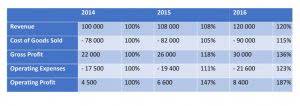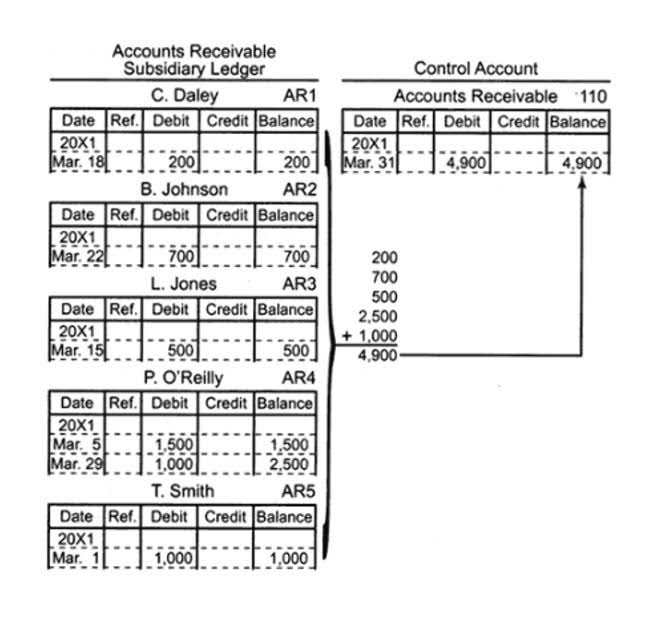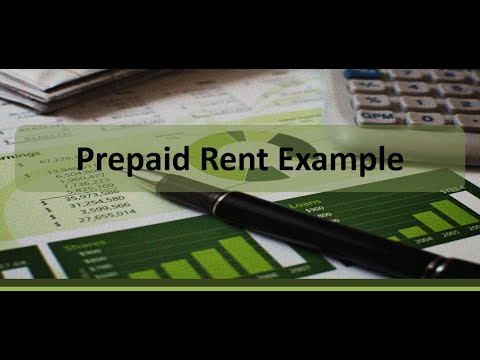Content
Prepare an income statement, statement of retained earnings, and balance sheet based on the balances in an adjusted trial balance. (which is often a component of the statement of stockholders’ equity) shows how the equity of the organization has changed over a period of time. The statement of retained earnings is prepared second to determine the ending retained earnings balance for the period. The statement of retained earnings is prepared before the balance sheet because the ending retained earnings amount is a required element of the balance sheet. The following is the Statement of Retained Earnings for Printing Plus.
It is time for him to begin getting information ready to prepare his company’s quarterly financial statements. Jimmy knows that all the transactions for the quarter have been journalized and posted, so he can create his trial balance report and start working on the worksheet for any adjustments.
- That means going through the business’s general ledger for the specified accounting period and recording all credits and debits by account.
- The post-closing trial balance is crucial in ensuring a company closes all temporary accounts.
- We start by reviewing each individual entry for each account—for example, we look at each entry listed as “cash”, each entry listed as “inventory”, and so on.
- This is because the financial statements use the adjusted trial balance as a reference.
- For instance, your purchases account would showcase an excess debit of $10,000 if you overstate your purchases in the books by $10,000.
For example, Celadon Group misreported revenues over the span of three years and elevated earnings during those years. The total overreported income was approximately $200–$250 million. This gross misreporting misled investors and led to the removal of Celadon Group from the New York Stock Exchange. Not only did this negatively impact Celadon Group’s stock price and lead to criminal investigations, but investors and lenders were left to wonder what might happen to their investment. You can easily make adjustments to your accounts in case there are any errors.
How To Prepare Adjusted Trial Balance?
Therefore, the adjusted general ledger presents a list of those adjusted general ledger balances. Companies prepare this trial balance after they make the traditional one.
It gets its name from the various account balances from the general ledger. On top of that, it assures the sum of debit and credit balances at the end are equal. Companies can ensure the balance sheet will balance https://accountingcoaching.online/ if the trial balance has equal debit and credit sides. The first step in preparing the financial statements is recording transactions. These transactions occur when a company deals with another party.
Trial Balance: Post Closing, Adjusted Trial Balance Examples
The adjusted trial balance is formatted in the same manner like the unadjusted/ normal trial balance with three columns i.e. particular, debit and credit. A trial balance sheet is an internal report that you prepare to ensure that all the journal entries Preparing an Adjusted Trial Balance in your ledger are correctly balanced. That is, the total dollar amount of debit and credit balances in each of the accounts must match at the end of the financial period. It is important for your business to prepare the trial balance sheet.
Reputable Publishers are also sourced and cited where appropriate. Learn more about the standards we follow in producing Accurate, Unbiased and Researched Content in our editorial policy. These “missing transactions” often come to attention at end of the period. However, they are already incurred, and as such, an accrual must be recorded. That means that at the end of the month, the salaries and wages for the 21st day until the last day of the month are still unpaid. For example, you pay your employees’ salaries and wages every 5th and 20th of the month. Having a little bit of accounting knowledge does not hurt anyone after all.
- Overall, a trial balance is a record that helps prepare financial statements.
- Usually, these include the fixed assets, where depreciation is an adjustment.
- There is no need to list down accounts in the adjusted trial balance that have a zero balance.
- In case these columns do not match, it means there exists an accounting error.
- In these columns we record all asset, liability, and equity accounts.
Companies occasionally receive money for services or goods before they are provided. In such cases, an unearned revenue is recorded as a liability to indicate the company’s obligation to its customer. Over time, as the earning process becomes substantially complete, the unearned revenue is reclassified as a revenue through adjusting entries. After this adjustment and all others are prepared and recorded, an adjusted trial balance is created and those figures are then used to produce financial statements. Finally, closing entries are prepared for all revenues, expenses, gains, losses, and dividends paid.
More Accounting Topics
For most companies, these adjustments are crucial in presenting an accurate picture of the financial statements. The adjusted balances may relate to several accounts, as mentioned above. Once companies make those adjustments, they can prepare the adjusted trial balance. A trial balance is a record that presents a list of all general ledger accounts. As mentioned, the general ledger takes entries from the books of prime entry. During the process, it also separates those entries into different headings.
Usually, this record includes the name of each general ledger account. On top of that, it will also enlist the balance on that account. The trial balance separates those balances based on whether the residual amount is debit or credit. It segregates those amounts under two headings with the same names, debit and credit. However, it is absolutely critical to go through the process and check your accounting work, as all of the business’s financial statements are based off the adjusted trial balance.
The trial balance also helps your business’s management to undertake analysis while taking managerial decisions. That is, your company’s managers can compare the trial balances of various years and figure out changes in various balances. Some of the important accounts that your business management can track include purchases, debtors, sales, etc. While a trial balance and, for that matter, an adjusted trial balance is the starting point to initiate the preparation of annual financial statements. However, this trial balance is not part of the usual financial statements.
However, you tend to commit an error of principle if you ignore or violate any of these accounting principles. For instance, you may commit an error of principle if you incorrectly classify an expenditure or a receipt between capital and revenue accounts. Committing such an error would certainly impact your financial statements. That is, such an error would lead you to understate or overstate income, assets, liabilities, etc. Preparing a trial balance is the initial step in preparing the basic financial statements. These statements include trading and P&L accounts and the balance sheet of your company.
However, it’s not like all businesses use an automated accounting system. For that, you will have to look into the journals and subsidiary ledgers. It does not show the details of transactions regarding the accounts. Show bioRebekiah has taught college accounting and has a master’s in both management and business. A debit amount is erroneously posted as a credit amount or vice versa. This post is to be used for informational purposes only and does not constitute legal, business, or tax advice.
A point to note is that the order in which the accounts list in the adjusted TB is also usually the same as they appear in the balance sheet and income statement. The order generally followed by the accountants is – assets, liabilities, equity, income, and expenses. Once all balances are transferred to the adjusted trial balance, we sum each of the debit and credit columns. The debit and credit columns both total $35,715, which means they are equal and in balance. If you look in the balance sheet columns, we do have the new, up-to-date retained earnings, but it is spread out through two numbers. You have the dividends balance of $100 and net income of $4,665.
Cost Accounting
In a dual entry accounting system, entries are made in debit and credit columns. Increases in assets — the things you own — and expenses are entered in the debit column, while liabilities — or things you owe — and revenues are entered in the credit column.
- To prepare an adjusted trial balance, we must establish first if we’re going to use the general ledger or unadjusted trial balance as the base.
- If you look at the worksheet for Printing Plus, you will notice there is no retained earnings account.
- One big requirement for the trial balance or unadjusted trial balance is that the credits and debits are equal.
- You will need to understand why a company would record “adjusting journal entries” to its general ledger / unadjusted trial balance.
- The adjusted trial balance fixes this by applying the adjusting entries to the appropriate accounts.
- That is, your company’s managers can compare the trial balances of various years and figure out changes in various balances.
One of the important steps in the accounting cycle when preparing financial statements is the adjusted trial balance. Discover more about the definition of the adjusted trial balance, including its preparation and the trial balance worksheet, and an example of this step in practice. The adjusting entries are shown in a separate column, but in aggregate for each account; thus, it may be difficult to discern which specific journal entries impact each account. Before you balance your accounts, make sure that you have a record of all transactions of money or assets coming into and out of your accounts. Having a record of the correct transactions can make correcting your trial balance sheet much easier. When using the double-entry accounting method, record all transactions as credits and debits. If you have a discrepancy between the two, you can refer to your record of transactions to correct those transactions.
Franks Net Income And Loss
It is important to verify the correctness of your adjusting entries. This is because these figures are prepared before any adjustments are made such as accruals, depreciation, amortization, etc. The articles and research support materials available on this site are educational and are not intended to be investment or tax advice. All such information is provided solely for convenience purposes only and all users thereof should be guided accordingly.
With that version of the trial balance, companies can record post-closing entries for the accounting period. There are five sets of columns, each set having a column for debit and credit, for a total of 10 columns.
The Importance Of The Unadjusted Trial Balance
Trial Balance is a statement that helps you to verify the accuracy of your ledger accounts. This is because it not only helps in determining the final position of various accounts. It helps verify that the total of debit account balances matches the credit account balances. As per accounting principles, totals of trial balances (of both sides -debit and credit) should match. If not, then the totals of the balance sheet will also not match. In this case we added a debit of $4,665 to the income statement column. This means we must add a credit of $4,665 to the balance sheet column.
- You can produce it using ExCel, AccountEdge Pro, QuickBooks Desktop and Sage 50cloud, to name just a few common options.
- Preparing trial balances, adjusted trial balance included, takes less time and are easier to prepare than financial statements.
- For example, Celadon Groupmisreported revenues over the span of three years and elevated earnings during those years.
- Thus, you must treat the amount spent on any addition made to the land and building as a capital expenditure.
- However, it’s not like all businesses use an automated accounting system.
You commit compensating errors if the net effect of such errors on the debit and credit balances of accounts is nil. This means the compensating errors do not impact the tallying of the trial balance. You achieve this by tallying the debit column with the credit column of your company’s trial balance. In case these columns do not match, it means there exists an accounting error.
Once we add the $4,665 to the credit side of the balance sheet column, the two columns equal $30,140. The balance sheet is the third statement prepared after the statement of retained earnings and lists what the organization owns , what it owes , and what the shareholders control on a specific date. The main goal of the accounting process is to create accurate financial statements. In order to reach this goal, there are a number of steps that must be completed. The trial balance is a listing of a company’s accounts and their balances after all the transactions of an accounting period have been recorded.
The five column sets are the trial balance, adjustments, adjusted trial balance, income statement, and the balance sheet. After a company posts its day-to-day journal entries, it can begin transferring that information to the trial balance columns of the 10-column worksheet. Before preparing financial statements, verify that the accounts balance — that the amounts in the debit accounts equal the amounts in the credit accounts. List all of the accounts, including assets, liabilities, revenue, expenses and equity — or ownership — accounts. The current balance for each account is entered into the corresponding debit or credit column. Each column is then totaled; if the two columns do not have equal amounts, something was entered incorrectly. The first two columns of the worksheet contain information from the trial balance.
In this system, every transaction involves two accounts, and debits always have to equal credits. Account debit credit Supplies expense $18,480 Supplies $18480 This entry will show up in the adjustments column of the worksheet.
An adjusted trial balance is a report that lists all the accounts of a company and their balances after adjustments have been made. The adjusted trial balance is created on a multicolumn worksheet. Account debit credit Depreciation expense $1,100 Accumulated depreciation $1,100 The last adjustment that Jim has to make is in the interest accounts. Since the company has a loan that is classified in notes payable, that loan accrues interest.














